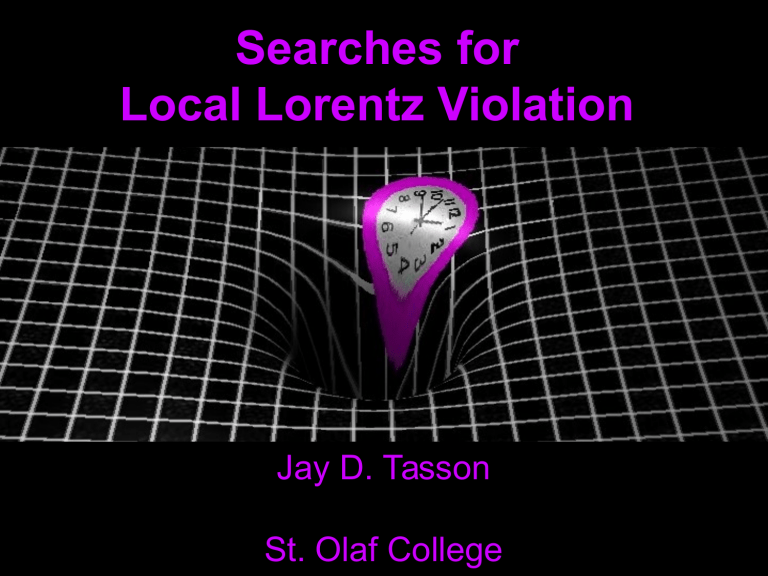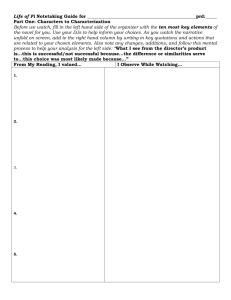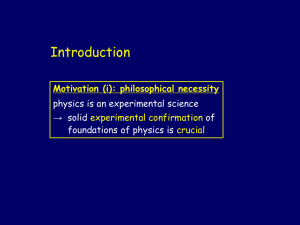Searches for Local Lorentz Violation Jay D. Tasson St. Olaf College

Searches for
Local Lorentz Violation
Jay D. Tasson
St. Olaf College
outline
• background
– motivation
– SME
• gravity theory
– pure-gravity sector
– matter-gravity couplings
• experiments & observations
motivation
E
Planck scale inconsistencies at higher energies known physics standard model general relativity
underlying theory at Planck scale
options for probing experimentally
• galaxy-sized accelerator
E unified theory
• suppressed effects in
sensitive experiments local Lorentz violation
• can arise in theories of new physics
• difficult to mimic
with conventional effects
Standard
Model
General
Relativity
Standard-Model Extension (SME)
test framework based on effective field theory which contains:
• General Relativity (GR)
• Standard Model (SM)
• arbitrary coordinate-independent Lorentz violation
Lorentz-violating terms
• constructed from GR and SM fields
• parameterized by coefficients for Lorentz violation
• samples
Colladay Kostelecký PRD '97, '98, Kostelecký PRD '04
y
What is Lorentz (rotation) violation?
If I turn my head, it’s clear that nothing has changed and relativity is preserved.
Turn
Experiment y
X X
y
What is Lorentz (rotation) violation?
I can’t fix this by rotating my coordinates. Relativity is violated
Turn
Experiment y
X X
Standard-Model Extension (SME)
test framework based on effective field theory which contains:
• General Relativity (GR) ys ics
• Standard Model (SM) ew
ph
• arbitrary coordinate-independent Lorentz violation ea rch
fo
Lorentz-violating terms l s
• constructed from GR and SM fields
• samples
A bro ad
Colladay Kostelecký PRD '97, '98, Kostelecký PRD '04
PPN vs. SME
framework parameterizes deviations from:
PPN
General Relativity
(including some
LLV) expansion about: GR metric
GR corrections?
Yes matter sector
/standard model corrections?
Lorentz invariant corrections?
No
Yes
SME exact LLI
(including some corrections to GR)
GR + standard model lagrangian
Yes, different ones!
Yes
(not primary interest)
parameterized deviations from GR are different!
Example: pure-gravity sector of minimal SME vs. PPN
• different coefficients
• can lead to qualitatively different results
If you currently investigate the PPN, you may be able to test additional physics using the SME!
Bailey Kostelecký PRD '06
background vectors and tensors are cute, but where could the come from?
• explicit Lorentz violation
– the universe just looks that way
– consistency problems with
Riemann geometry can arrise
1
• spontaneous Lorentz violation
– a vector or tensor field gets a vacuum-expectation value
– nonzero VEV observed for a scalar particle, the Higgs
(no Lorentz violation)
– VEV for vector or tensor would be my red arrows
– consistent with Riemann geometry
1 Kostelecký PRD '04
tests
• compare experiments pointing in different directions
• compare experiments at different velocities
• compare particles and antiparticles
• SME
– predictive
– quantitative comparisons
• observe:
– Lorentz violation
– ‘conventional’ field associated with larger-scale source eg. spacetime torsion
1
, gravitomagnetism
2
1 Kostelecký Russell JT PRL '08
2 JT PRD '12
SME experimental and observational searches
• atom-interferometer tests (Mueller, Chiow, Herrmann, Chu, Chung)
• lunar laser ranging (Battat, Chandler, Stubbs)
• pulsar-timing observations (Shao)
• short-range gravity tests (Speake, Long,...)
• trapped particle tests (Dehmelt,Gabrielse, …)
• spin-polarized matter tests (Adelberger, Heckel, Hou, …)
• clock-comparison tests (Gibble, Hunter, Romalis, Walsworth, …)
• tests with resonant cavities (Lipa, Mueller, Peters, Schiller, Wolf, …)
• neutrino oscillations (LSND, Minos, Super K, …)
• muon tests (Hughes, BNL g-2)
• meson oscillations (BABAR, BELLE, DELPHI, FOCUS, KTeV, OPAL, …)
• astrophysical photon decay
• cosmological birefringence
• CMB analysis
• .....
SME experimental and observational searches
• atom-interferometer tests (Mueller, Chiow, Herrmann, Chu, Chung)
• lunar laser ranging (Battat, Chandler, Stubbs)
• pulsar-timing observations (Shao)
• short-range gravity tests (Speake, Long,...)
• trapped particle tests (Dehmelt,Gabrielse, …)
• spin-polarized matter tests (Adelberger, Heckel, Hou, …)
• clock-comparison tests (Gibble, Hunter, Romalis, Walsworth, …)
• tests with resonant cavities (Lipa, Mueller, Peters, Schiller, Wolf, …)
• neutrino oscillations (LSND, Minos, Super K, …)
• muon tests (Hughes, BNL g-2)
• meson oscillations (BABAR, BELLE, DELPHI, FOCUS, KTeV, OPAL, …)
• astrophysical photon decay
• cosmological birefringence
• CMB analysis
• .....
SME experimental and observational searches
• atom-interferometer tests (Mueller, Chiow, Herrmann, Chu, Chung)
• lunar laser ranging (Battat, Chandler, Stubbs)
• pulsar-timing observations (Shao)
• short-range gravity tests (Speake, Long,...)
• trapped particle tests (Dehmelt,Gabrielse, …)
• spin-polarized matter tests (Adelberger, Heckel, Hou, …)
• clock-comparison tests (Gibble, Hunter, Romalis, Walsworth, …)
• tests with resonant cavities (Lipa, Mueller, Peters, Schiller, Wolf, …)
• cosmological birefringence
• CMB analysis
• .....
overview of Lorentz violation/SME
• Tasson, Rep. Prog. Phys. 77, 062901 (2014), arXiv:1403.7785
– simple examples
– general overview
– video abstract
Lorentz violation in gravitational experiments
gravitational sector 1 :
●
Lorentz violation in the gravitational field
●
Einstein-Hilbert + corrections gravitationally coupled matter sector 2 :
●
Lorentz violation in matter gravity couplings
●
species dependent couplings leads to WEP violation
1 Bailey Kostelecký PRD '06, Bailey Kostelecký Xu arXiv:1410.6162
2 JT Kostelecký PRD '11
gravity sector
gravity sector: dynamics of gravitational field alone conventional pure-gravity source leading Lorentz violation source
●
● minimal post-Newtonian effects originate from experiments that involve the gravitational field are relevant
gravity sector
• minimal effects (mass dimension 4 operators) via post Newton metric 1
• dimension 6 operators 2
• dimension 6 effects via modified 1/r behavior anisotropic combination of dim 6 coefficients 1 Bailey Kostelecký PRD '06
2 Bailey Kostelecký Xu arXiv:1410.6162
gravitationally coupled matter sector
matter sector: kinematics and interactions of particles conventional gravitationally coupled matter sector
Lorentz violation
●
● source-dependent field distortions test-particle dependent responses
countershaded Lorentz violation
• upon investigating spontaneous breaking we find
Minkowski-spacetime coefficients unobservable shift in fermion phase observable effects via gravity coupling
• for matter is unobservable in flat-spacetime tests
• observable effects are suppressed by the gravitational field
• could be large (~ 1eV) relative to existing matter-sector bounds
Kostelecký JT PRL '09
classical results
S and T denote composite coefficients for source and test respectively
• modified metric & particle equation of motion
• experimental hooks
– particle-species dependence
– time dependence
experiments
• Earth-source lab tests
- gravimeter
Chung et al. PRD '09
Mueller et al. PRL '08
- WEP
Hohensee Mueller Wiringa PRL '13
Hohensee et al. PRL '11
• space-based WEP
• exotic tests
- charged matter
- antimatter
- higher-generation matter
• solar-system tests
- laser ranging
Battat Chandler Stubbs PRL '07
- perihelion precession
• light-travel tests
- time delay
- Doppler shift
- red shift
• clock tests
- null redshift
- comagnetometers
• short-range gravity
Long Kostelecký arXiv:1412:6362
Panjwani Carbone Speake in CPT'10
• gravity probe B
Bailey Everett Overduin PRD '13
• pulsar tests
Shao PRL '14
Shao arXiv:1412.2320
experiments
• Earth-source lab tests
- gravimeter
Chung et al. PRD '09
Mueller et al. PRL '08
- WEP
Hohensee Mueller Wiringa PRL '13
Hohensee et al. PRL '11
• space-based WEP
• exotic tests
- charged matter
- antimatter
- higher-generation matter
• solar-system tests
- laser ranging
Battat Chandler Stubbs PRL '07
- perihelion precession
• light-travel tests
- time delay
- Doppler shift
- red shift
• clock tests
- null redshift
- comagnetometers
• short-range gravity
Long Kostelecký arXiv:1412:6362
Panjwani Carbone Speake in CPT'10
• gravity probe B
Bailey Everett Overduin PRD '13
• pulsar tests
Shao PRL '14
Shao arXiv:1412.2320
time dependence
• standard Sun-centered frame
• boost and rotation of test annual & sidereal variations
lab tests
acceleration of a test particle T annual variations
• monitor acceleration of one particle
• monitor relative behavior of particles
• frequency and phase distinguish from other effects
lab tests
acceleration of a test particle T sidereal variations unsuppressed in some tests having horizontal sensitivity
Kostelecký & Tasson PRD 2011
Kostelecký & Tasson PRD 2011
Kostelecký & Tasson PRD 2011
Kostelecký & Tasson PRD 2011 improvement potential via atom interferometry:
●
max reach 4 to 6 orders of magnitude improvement
●
special linear combinations 10 orders of magnitude improvement
Dimopoulos et al. PRD 2008
Kostelecký & Tasson PRD 2011 signals are qualitatively distinct from other sources of WEP violation due to characteristic periodicity improvement potential:
●
max reach 4 to 6 orders
●
special combinations 10 orders
WEP tests considered atom interferometry torsion pendulum drop tower balloon drop tossed masses
...and any WEP test can be used
experiments
• Earth-source lab tests
- gravimeter
Chung et al. PRD '09
Mueller et al. PRL '08
- WEP
Hohensee Mueller Wiringa PRL '13
Hohensee et al. PRL '11
• space-based WEP
• exotic tests
- charged matter
- antimatter
- higher-generation matter
• solar-system tests
- laser ranging
Battat Chandler Stubbs PRL '07
- perihelion precession
• light-travel tests
- time delay
- Doppler shift
- red shift
• clock tests
- null redshift
- comagnetometers
• short-range gravity
Long Kostelecký arXiv:1412:6362
Panjwani Carbone Speake in CPT'10
• gravity probe B
Bailey Everett Overduin PRD '13
• pulsar tests
Shao PRL '14
Shao arXiv:1412.2320
exotic tests
• variations of above tests involving experimentally challenging matter
• charged ma tte r
– separate proton and electron coefficients
– theoretically interesting -- bumblebee electrodynamics improvement potential: sensitivity to remaining 4 unconstrained coefficients
• higher-generation matter first sensitivity to for muons, for example
• antimatter
– separate CPT even and odd coefficients
– differing gravitational response for matter and antimatter
experiments
• Earth-source lab tests
- gravimeter
Chung et al. PRD '09
Mueller et al. PRL '08
- WEP
Hohensee Mueller Wiringa PRL '13
Hohensee et al. PRL '11
• space-based WEP
• exotic tests
- charged matter
- antimatter
- higher-generation matter
• solar-system tests
- laser ranging
Battat Chandler Stubbs PRL '07
- perihelion precession
• light-travel tests
- time delay
- Doppler shift
- red shift
• clock tests
- null redshift
- comagnetometers
• short-range gravity
Long Kostelecký arXiv:1412:6362
Panjwani Carbone Speake in CPT'10
• gravity probe B
Bailey Everett Overduin PRD '13
• pulsar tests
Shao PRL '14
Shao arXiv:1412.2320
short range
anisotropic combination of dim 6 coefficients
Time & orientation dependence
●
qualitatively different from other 1/r deviations
●
sensitivities require data analysis
●
crude estimate of reach for given experiment improvement:
●
first dimension 6 sensitivities via Indiana cantilever experiment
10 -9 m 2
Long Kostelecký arXiv:1412:6362
●
additional experiments offer improved sensitivity & additional coefficients
Bailey Kostelecký Xu arXiv:1410.6162
experiments
• Earth-source lab tests
- gravimeter
Chung et al. PRD '09
Mueller et al. PRL '08
- WEP
Hohensee Mueller Wiringa PRL '13
Hohensee et al. PRL '11
• space-based WEP
• exotic tests
- charged matter
- antimatter
- higher-generation matter
• solar-system tests
- laser ranging
Battat Chandler Stubbs PRL '07
- perihelion precession
• light-travel tests
- time delay
- Doppler shift
- red shift
• clock tests
- null redshift
- comagnetometers
• short-range gravity
Long Kostelecký arXiv:1412:6362
Panjwani Carbone Speake in CPT'10
• gravity probe B
Bailey Everett Overduin PRD '13
• pulsar tests
Shao PRL '14
Shao arXiv:1412.2320
pulsars
●
minimal gravity sector implies effects on orbits and timing 1
●
constraints on coefficients achieved using observations of 2 :
B1937+21, J1744−1134, B1913+16, B1534+12, J0737−3039A, B2127+11C,
J1738+0333, J1012+5307, J0348+0432, J1802−2124, J0437−4715, B1855+09,
J1909−3744
●
“The null detection of any beyond-GR effects in binary pulsars constrains LV orbital dynamics.” improvement:
●
first consideration of strong gravity
●
several orders of magnitude improvement
●
further improvement via direct fit to SME, observation improvements, & additional SME phenomenology
1. Bailey Kostelecký PRD '06 2. Shao PRL '14
●
Summary
Lorentz violation searches have potential to detect Planckscale physics with existing technology
●
The SME provides a field-theory based test framework
●
Lorentz violation introduces qualitatively new signals in experiments
●
Much work has been done but much remains unexplored


